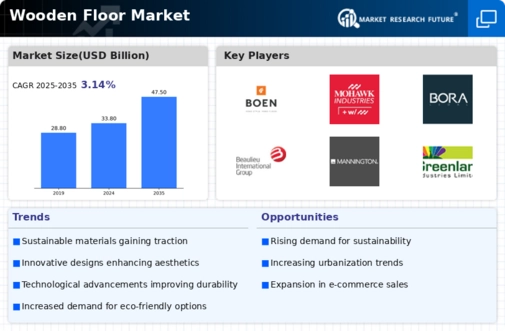Wooden Floor Size
Wooden Floor Market Growth Projections and Opportunities
Some factors shape the hardwood floor industry. The global economy is an important market factor. Economic stability and prosperity drive demand for wooden flooring. During upturns in the economy, homeowners spend more on renovations thus increasing the demand for hardwood floors.
The size of the Wooden Floor Market was $31.5 billion by 2022. From 2023’s 32.63bn USD to 2032’s 43.3bn USD, hardwood flooring industry should increase at CAGR of over 3%.
Customers’ preferences and lifestyle changes are other relevant facts here as well. Hardwood floors have become a popular choice because people prefer long-lasting and attractive floors. Additionally, wooden floors are ecological and sustainable.
Technological advancements influence sales of wood flooring products too. Manufacturing improvements and new coatings or treatments enhance quality, durability of timber floors; they also include engineered wood products which have expanded the market by providing cheaper yet high quality alternatives.
Government forestry and environmental policies affect market pricing as well as availability of resources used in producing hardwood flooring materials. Availability and pricing of raw materials for hardwood floorings are affected by logging standards as well as policies for sustainable forestry practices that aim at protecting forests from damage through illegal harvesting methods while promoting use only those trees which can be re-planted again due to their ability grow quickly enough during one generation period before being harvested again to produce building materials such as furniture etc., without causing any negative impact on environment (e.g., CO2 emission).
Wooden floor demand is tied to construction trends within this housing sector too so especially in real estate booms when these building units require new surfaces like wooden ones particularly if made out from solid pieces which ensure warm feel underfoot even after several decades since installation was initially done. Consumer income affects sales of wood floorings too. More money in people’s pockets means that more expensive types of hardwood flooring can be bought. However, customers may go for cheaper alternatives when the economy slumps hence wooden floor sales are damaged.
Wooden floor manufacturers must follow these design trends to stay competitive and fulfill customer expectations. This will enable them to meet consumer demand and remain competitive with other suppliers across different countries where consumers have different preferences from one country to another due various cultural factors such as tastes related fashion or lifestyle choices (e.g., whether it is important how people dress themselves each day).












Leave a Comment